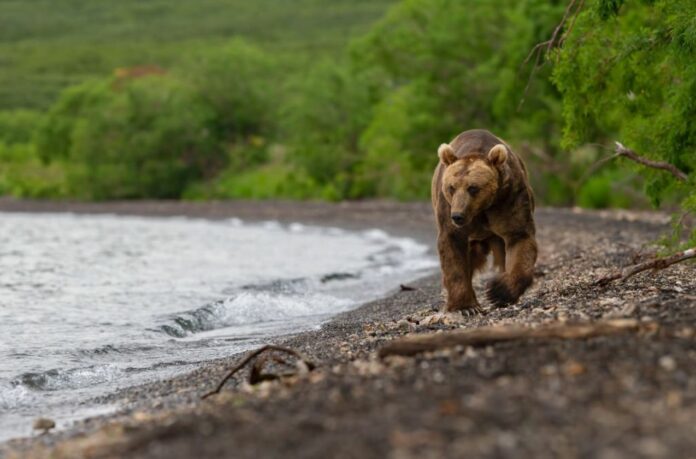Not all brown bears are grizzly bears, even though they may be referred to as such in certain regions. In Yellowstone National Park, black bears are more common than grizzly bears, which are brownish in color. In the Pacific Northwest, the term “brown bear” typically refers to a grizzly bear.
American black bears (Ursus americanus) are not always black in color and can actually come in a variety of shades such as brown (also known as cinnamon), blond, or bluish-grey. Some even have coats with a mixture of colors. It can be difficult to distinguish a cinnamon-colored Ursus americanus from a brown (grizzly) Ursus arctos bear based on body shape and size alone. One theory for the cinnamon coloring of Ursus americanus is that it helps with camouflage or defense by resembling a grizzly bear.
Researchers at HudsonAlpha, the University of Memphis, and the University of Pennsylvania have recently uncovered the cause of the cinnamon coloring in black bears, providing insight into the color variation among these animals.
Responsible gene variation for cinnamon-colored black bears
Researching the evolution and genetics of bears has been the focus of Emily Puckett’s work as an Assistant Professor of Biological Sciences at the University of Memphis. She gathered hundreds of DNA and hair samples from North American bears with help from colleagues in state, provincial, and federal wildlife organizations. She worked with Greg Barsh, MD, PhD, a Faculty Investigator at HudsonAlpha and an expert on animal pigmentation, to figure out why black bears aren’t always black.
Melanocytes are skin cells responsible for making mammalian pigment. Melanin comes in two different colors: eumelanin, which is black or brown, and pheomelanin, which is red or yellow. It is generally acknowledged that variations in hair, eye, and skin color result from genetic diversity in melanin production. The research team used photos of bears and analyzed the chemical composition of their hair samples to discover that cinnamon-colored black bears, like grizzly bears, have lower levels of eumelanin.
An analysis of the genome sequences of nearly 200 bears revealed multiple missense mutations in the gene Tyrosinase-related protein 1 (TYRP1): cinnamon-colored black bears have a mutation known as TYRP1R153C, while the majority of grizzly bears (but not all of them) have a mutation known as TYRP1R114C. It makes sense that cinnamon and grizzly bears have less eumelanin since the TYRP1 gene creates an enzyme inside melanocytes that aids in the production of eumelanin. Moreover, the TYRP1R153C and TYRP1R114C mutations disrupt melanin production and distribution, as shown by functional investigations conducted by Mickey Marks, PhD, Professor of Pathology at the University of Pennsylvania, and his team.
“When we looked at other species, we were surprised to find the TYRP1R153C variant responsible for cinnamon U. americanus is identical to one previously described as a cause of oculocutaneous albinism (OCA3) in humans,” adds Barsh.
Persons of African or Puerto Rican heritage are disproportionately affected by OCA3, which is characterized by reddish complexion and hair and frequent visual impairments. Puckett, however, claims that bears with TYRP1 mutations have normal skin and eyes.
Where and when did the cinnamon morph originate?
Most cases of the TYRP1R153C variation were discovered in the southwestern United States, with decreasing numbers in Southeast Alaska and the Yukon Territory. TYRP1R153C was linked to the cinnamon color of black bears, as well as to their chocolate and light brown colors. This means that it explains almost all of the different colors of U. americanus.
The data they collected helped the researchers understand more about the TYRP1R153C mutation. One theory is that it might have originated in grizzly bears and subsequently spread to black bears, however demographic research suggests that this is not the case. Instead, the TYRP1R153C mutation appeared naturally in western United States black bears some 9,360 years ago and spread as the bears expanded their territory.
“Based on its wide range today, the TYRP1R153C mutation that arose in black bears over 9,000 years ago probably gave an advantage to the cinnamon bears,” adds Puckett. “We used genetic modeling and simulations to predict the selective forces acting on the cinnamon morph. But our predictions ruled out the grizzly mimicry hypothesis as well as another hypothesis having to do with thermoregulation.”
The team proposes a new hypothesis for the appearance of the coat color variant: crypsis, or the ability to blend into the surroundings in order to conceal oneself. Crypsis is typically seen in prey animals and ambush predators that match the colors of their surroundings. In this case, the researchers suggest that crypsis could be a more general adaptive mechanism for large species.
“These results illustrate how genetic variation in melanin biosynthesis can underlie iconic phenotypes and inform our understanding of color variation and recent evolution in large carnivores,” adds Barsh.
Image Credit: Valerio Ferraro/REDA&CO/Universal Images Group via Getty Images
